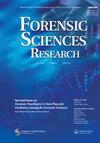Crime Scene Novichok—Optical Detection of Fourth-Generation Agents (FGAs) Using Handheld Forensic Light Sources
IF 1.4
4区 医学
Q3 MEDICINE, LEGAL
引用次数: 1
Abstract
Novichok-like or fourth-generation agents (FGAs) are chemical warfare agents (CWAs) which have been gaining attention since their use in assassination attempts on Sergei Skripal and Alexei Navalny. Due to their physicochemical properties, these substances are difficult to detect by implemented technologies, resulting in massive response efforts if their occurrence is suspected in a civilian environment. In this work, an approach is presented that uses handheld forensic light sources to visually detect surfaces contaminated with Novichok. More than 100 different wavelength combinations were applied to seven substances chosen to represent the newly listed schedule 1 subgroups in the Annex on Chemicals of the Chemical Weapons Convention. One waveband was identified as promising, which allowed the optical detection of all tested substances. Several surfaces, which could be affected in case of a possible attack using novichok-like nerve agents, were also successfully evaluated. The proposed procedure could be implemented for CBRN responders and security agencies to significantly reduce response efforts, thereby diminishing the overall threat posed by this group of chemicals (FGAs). This procedure was also extended to carbamates and CWAs.基于手持式法医光源的第四代探员(FGAs)犯罪现场诺维乔克光学检测
诺维乔克样或第四代毒剂(FGAs)是一种化学战剂(CWAs),自从它们被用于暗杀谢尔盖·斯克里帕尔和阿列克谢·纳瓦尔尼以来,一直受到关注。由于这些物质的物理化学性质,现有技术很难检测到这些物质,因此,如果怀疑它们在民用环境中出现,则需要大量的应对工作。在这项工作中,提出了一种方法,使用手持式法医光源来视觉检测被诺维乔克污染的表面。对选择代表《化学武器公约关于化学品的附件》中新列出的附表1子组的七种物质采用了100多种不同的波长组合。一个波段被确定为有希望的,它允许对所有被测试物质进行光学检测。几个可能受到诺维乔克类神经毒剂攻击影响的表面也被成功评估。建议的程序可用于CBRN响应者和安全机构,以显着减少响应工作,从而减少这类化学品(FGAs)构成的总体威胁。该程序也扩展到氨基甲酸酯和CWAs。
本文章由计算机程序翻译,如有差异,请以英文原文为准。
求助全文
约1分钟内获得全文
求助全文

 求助内容:
求助内容: 应助结果提醒方式:
应助结果提醒方式:


